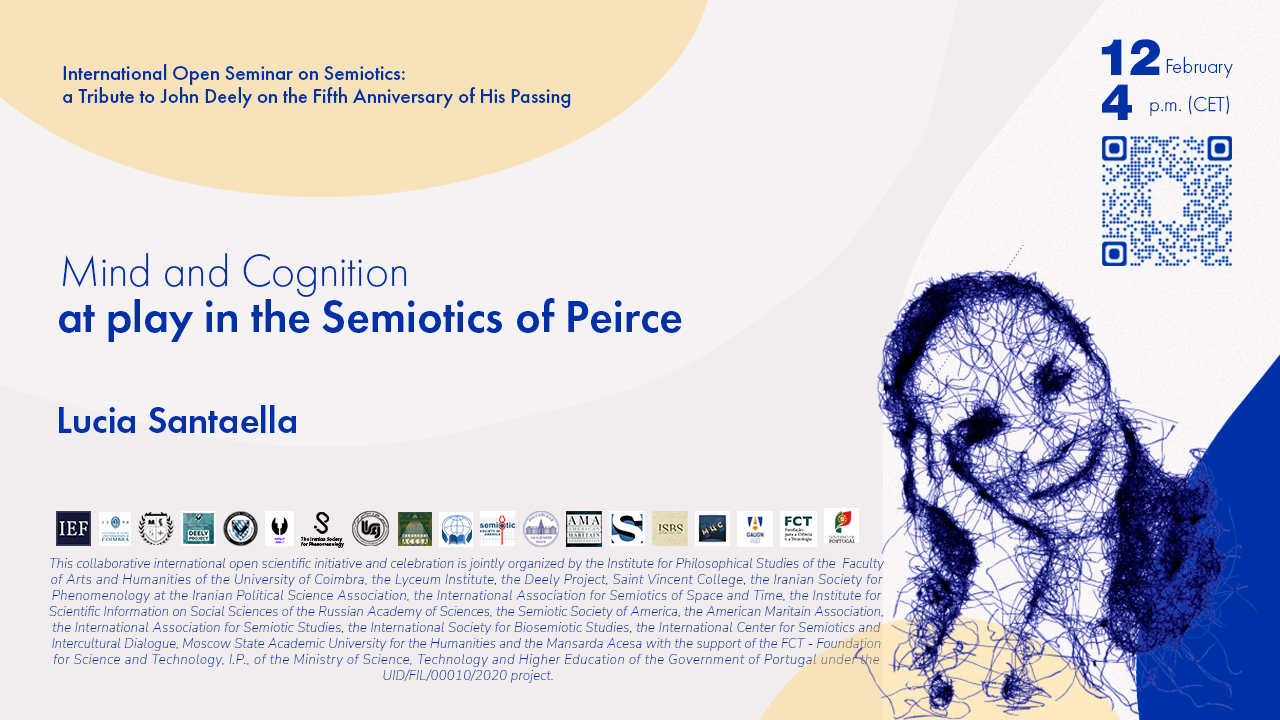Mind and Cognition at play in the Semiotics of Peirce (February 12)
Get the most out of this lecture… and you will be surprised at what mental and cognitive capabilities are all about.

ZOOM:
IO2S ⚘ Mind and Cognition at play in the Semiotics of Peirce
February 12, 2022 / 4pm (CET), 3pm (UTC)
Lecturer: Lucia Santaella
Commentator: Gary Shank
Chair: Yulia Nikitenko
Meeting room: https://zoom.us/j/93929663109
Stream link: https://youtu.be/Udki8XtUAN8
Lucia Santaella is a researcher 1A of CNPq, graduated in Portuguese and English Literature. She is a Full Professor in the Post-Graduate Program in Communication and Semiotics and Director of the Post-Graduate Program in Technologies of Intelligence and Digital Design at PUC-SP – Pontifical Catholic University of São Paulo, with a PhD in Literary Theory received from PUC-SP, in 1973, plus a Habilitation Thesis (Livre-Docência, in Portuguese) in Communication Sciences at ECA-USP – School of Communications and Arts of the University of São Paulo, achieved in 1993. She is the Director of the CIEP – International Center for Peircean Studies at PUC-SP. She is the Honorary President of the FELS – Latin American Federation of Semiotics, as well as the Brazilian correspondent of the Argentinian National Academy of Fine Arts, appointed in 2002. She was elected the President of the Charles S. Peirce Society, USA, for 2007. Santaella is also a member of the Advisory Board of the Peirce Edition Project in Indianapolis, USA, as she is a member of the Bureau of Regional — Continental Coordinators of the ICI – International Communicology Institute. She was also an associate member of the IAG Kulturforschung – Center for Interdisciplinary Research in Culture, Uni Kassel – University of Kassel, 1999-2009. She received the Jabuti Prize in 2002, 2009, 2011 and 2014, just as the Sergio Motta Art and Technology Award, in 2005 and the Luiz Beltrão Communication Sciences Award, for academic maturity, in 2010. She was a guest lecturer at the Free University of Berlin, in 1987, at the University of Valencia in 2004, at the Uni Kassel in 2009, at the University of Évora in 2010, at the Buenos Aires National University of the Arts, in 2014, and also at the Michoacan University of Saint Nicholas of Hidalgo, Mexico, 2015. She was an associate researcher at the Indiana University Bloomington‘s Research Center for Language and Semiotic Studies, in repeated stages of research, especially in 1988, with a Fulbright grant. At the same university, she completed postdoctoral studies in 1993, with a CNPq grant. Since 1996, she undertook postdoctoral internships in Kassel, Berlin and Dagstuhl, Germany, under the auspices of the DAAD/FAPESP deal. 258 MSc’s, PhD’s and postdoctoral fellows have pursued their degrees under her direction dating from 1978 to the present, while she has also been responsible for supervising 12 postdoctoral researchers. She has published 45 books of which 6 are in co-authorship and two are critical studies. She also organized the edition of 16 books. In addition to the books, Lucia Santaella has more than 400 articles published in scientific journals in Brazil and abroad. Her most recent research areas are: Communication, Cognitive and Computational Semiotics, Technological Aesthetics and Philosophy and Methodology of Science.
Gary Shank is a Professor of Educational Research at Duquesne University in Pittsburgh, PA. He has been active in semiotics since 1979, when he attened his first Semiotic Society of America meeting at his alma mater, Indiana University. He has been active in semiotics and educational research since then. He was a founding member and Past-President of the Semiotics in Education SIG at the American Educational Research Association. He has published in Semiotica and the American Journal of Semiotics. He has been plenary speaker for the Biosemiotics Convening, where he talked about the Semiotics of PS 101. He has also published extensively in qualitative research, where he has authored or co-authored three related books. In this Educational Semiotics book series titled “Signs and Symbols in Education,” Dr. Shank is looking for visionary works on education and semiotics and how they can reinforrce and build from each other.

Leave a Reply
You must be logged in to post a comment.